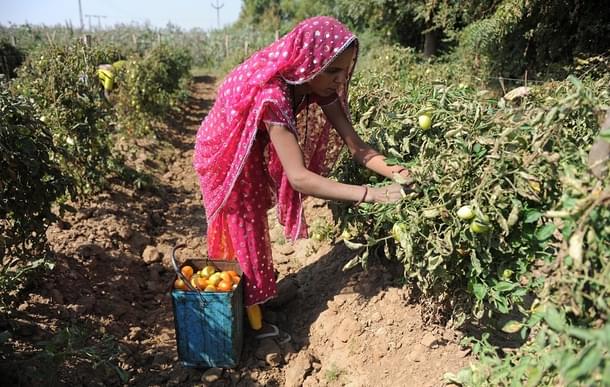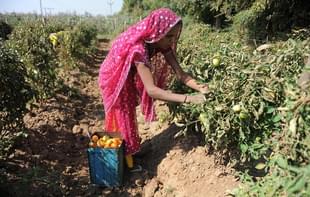Magazine
New Approach, Greater Speed Required for Agricultural Development
Samir Shah
Feb 11, 2016, 10:24 PM | Updated Feb 12, 2016, 05:17 PM IST
Save & read from anywhere!
Bookmark stories for easy access on any device or the Swarajya app.


Agricultural development has to be seen, not as philanthropy, but as a market investment, creating a system where stakeholders have the incentive to innovate, resilience to endure risk, and capital to invest in growth.
It is almost a truism now that achieving India’s long-term inflation target of four percent will hinge on enhancing food supply, market-based pricing of agricultural produce, and reducing price distortions. The big question is: By when?
Indian farmers are increasingly impatient with the slow pace of change because incomes have been bludgeoned by two consecutive years of drought and agricultural growth rate has slowed to 0.2 percent in 2015. It is imperative that we seek solutions that are transformational, profound and yet quick to show results.
The smartest way to achieve this seemingly impossible task would be to re-purpose and expand the scope of market infrastructure that already exists. This will spark a virtuous cycle of increasing skill and investment in the food system to improve agricultural productivity, sustainability and prosperity.
In Budget 2015, the Finance Minister announced a national market for agricultural produce so that farmers can escape from the limitations of geography and the traditional chain of intermediaries to receive the best possible price. The establishment of the national market as an electronic trading portal has a better chance of being effective even with the mandi as a back end by enabling farmers’ options for sale and access to markets. But here too, investment to enable transport and storage of produce is essential for the system to function. It is complicated by regulatory inefficiencies, state laws and dithering on FDI in multi-brand retail.
A quicker way to achieve the same result is to give a harder push to the national market already created by the government. The key to success lies in the implementation and in harnessing the necessary skills and experience needed to implement this in every state. Although a one-size-fits-all solution is desirable, it is not entirely practical in India. It will be important to recognize each state as a critical partner and stakeholder and work first at the state level and then make the various state-level implementations inter-operable.
In 2014, the government allowed regulated commodity exchanges to create a new online platform for direct buying and selling of crops by farmer collectives such as Farmer Producer Organisations (FPOs), wholesalers and processors. The masterstroke of this platform is that it can co-exist with Agricultural Produce Marketing Committee (APMC) market yards and does not require substantial changes in state laws to become operational pan-India.

The objective was that since agricultural markets in India are highly fragmented, allowing farmers the freedom to sell to anyone from anywhere, without fear of counter-party risk and cheating, would lead to a more developed and efficient market. Since state government agencies are among the biggest purchasers of agricultural commodities, they should also be incentivized to procure directly from farmers using this transparent online mechanism. Farmers whose location forces them to remain outside the purview of government procurement would immediately benefit by access at the click of a mouse. That will further build farmer confidence in this new, cheaper and faster way to do business.
The ripple effect will be long-lasting. The prices at which commodities are traded on this national online platform would become the de facto benchmark. The farmer can use the information to drive a harder bargain. Since buyers will not be physically examining each heap before quoting a price, as is done in the traditional mandi, farmers would automatically be compelled to ensure that their crop meets fair, average quality standards. Once Indian crops genuinely become commoditized with uniform grades and specifications, farmers will no longer be press-ganged into giving discounts.
Another existing market infrastructure whose scope can be expanded is modern warehousing. India’s network of private warehousing has rapidly widened in the last couple of years, thanks to a substantial inflow of FDI and private equity. Apart from the savings through more scientific storage of commodities, the government can employ this network to fight food price manipulation.

All warehouses should be made to register with the Warehousing Development and Regulatory Authority through a simple process and encouraged to adopt an electronic accounting system for reporting exactly how much commodity is lying in their premises. Once there is transparency, the government need not be suspicious of wholesalers and stockists who are performing the important economic function of holding the inventory of crops that are harvested once a year and consumed over the next 12 months. There will be no need to resort to crisis mechanisms such as stock limits and raids on godowns.
That is not all. The same warehouses can also be used to meet the objective of financial inclusion in rural areas. Instead of taking pre-harvest loans that need land/house as collateral, even the poorest farmer can avail of post-harvest loans by using his produce as collateral. Banks can be encouraged to lend against the goods stocked by the farmer in regulated godowns. In one stroke, the much-needed capital investment will start flowing into agriculture.
Last but not the least, the government should use its gigantic data-gathering machinery on the ground as well as space satellites to collect more reliable information on crop harvests. Good business decisions require credible and timely information and it is the government’s duty to quickly step into the breach.
A quick way to show results would be to adopt a pilot project approach, and focus initially on ensuring accurate estimates for oilseeds and pulses. Once the right mix of space technology, drones, and physical verification is achieved, it can be extended to other crops.
Agriculture is a primary driver of our economic growth. The Finance Minister has stated that turning agriculture around will be his top priority in the new financial year. That is heartening. There appears to be a fundamental dichotomy between rising food inflation and falling farm incomes which needs to be immediately addressed.
It shows that the Indian farmer is receiving only a small fraction of the price paid by the final consumer. In order to facilitate productivity growth, it is important to ensure that farmers receive lucrative prices for their produce.
The current state of Indian agriculture shows that we have to go beyond isolated interventions and adopt a comprehensive, long-term approach for improving whole food systems. Farmers have a fundamental right to access free, fair and regulated markets. Instead of approaching agricultural development with philanthropy, we have to approach it as a market investment, creating a system where stakeholders have the incentive to innovate, resilience to endure risk and capital to invest in growth.
Transformations have begun with new models for improving productivity, supported by favourable policy, infrastructure and market structure. Only speed is lacking. Farmers need to see faster impact. Hopefully, the Budget will smartly use available tools to address that.





